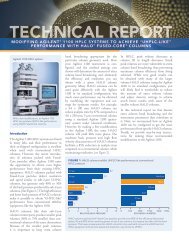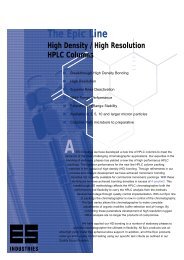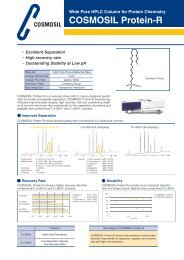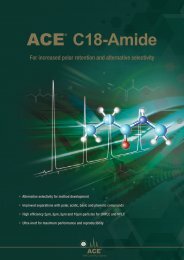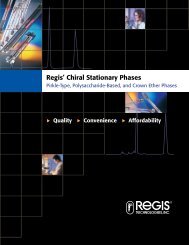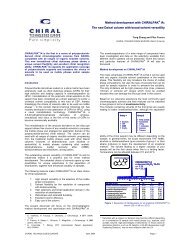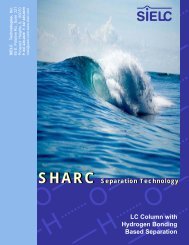Asahipak - Hplc.eu
Asahipak - Hplc.eu
Asahipak - Hplc.eu
- No tags were found...
You also want an ePaper? Increase the reach of your titles
YUMPU automatically turns print PDFs into web optimized ePapers that Google loves.
Precautions for polar polymer analysisSize exclusion chromatography analysis of polar-polymer can be influenced by unexpected interactions in the column.These interactions will result in changing elution patterns and may cause the invalid molecular weight calculations.It is important to reduce them in order to obtain the accurate molecular weight distribution.InformationInterfering interactions likely to be observedInteractions between the analyte and the packing materialsHydrophobic interactionThe analyte is adsorbed into the packing material.This delays the analyte elution, and thus results inunderestimation of its molecular weight (Figure B, D).Ionic interaction(1) Ion ExclusionThe analyte is repelled from the packing material.This accelerates the analyte elution, and thus resultsin overestimation of its molecular weight (Figure A, C)(2) Ion ExchangeThe analyte is adsorbed onto the packing material.This delays the analyte elution, and thus results inunderestimation of its molecular weight (Figure B, D).Interaction within and between the analyteIonic repulsion effects observed within the multivalentmacromolecules causes structure expansionThis accelerates the analyte elution, and thus results inoverestimation of its molecular weight (Figure A).Association between the moleculesAssociated molecule detected as a larger molecule(Figure A).Interactions between the analyte and the solventThe multivalent ion of the solvent works as a bridge tobind ionic molecules (analyte).Exclusion limitMWlog MWElution will beaccelerated.Exclusionvolume(C)(A)Elution will beretarded.(B)Permeationvolume(D)43Precautions for polar polymer analysisMethods to reduce interactionsOrganic solvent SEC (GPC) columnsAqueous SEC (GFC)Ionic InteractionAdd salt(Example) Add LiBr to DMFAdd CF 3 COONa to HFIPIonic InteractionAdd saltHydrophobic interactionLower the polarity of the eluent(Example) Change the eluent from DMF to THFHydrophillic interactionHydrophobic interactionIncrease dissociation of the analyteCationic polymer Lower the pHAnionic polymer Higher the pHLower the eluent polarity(Example) Add acetonitrile or methanolIncrease the polarity of the eluent(Example) Change the eluent from THF to DMF



